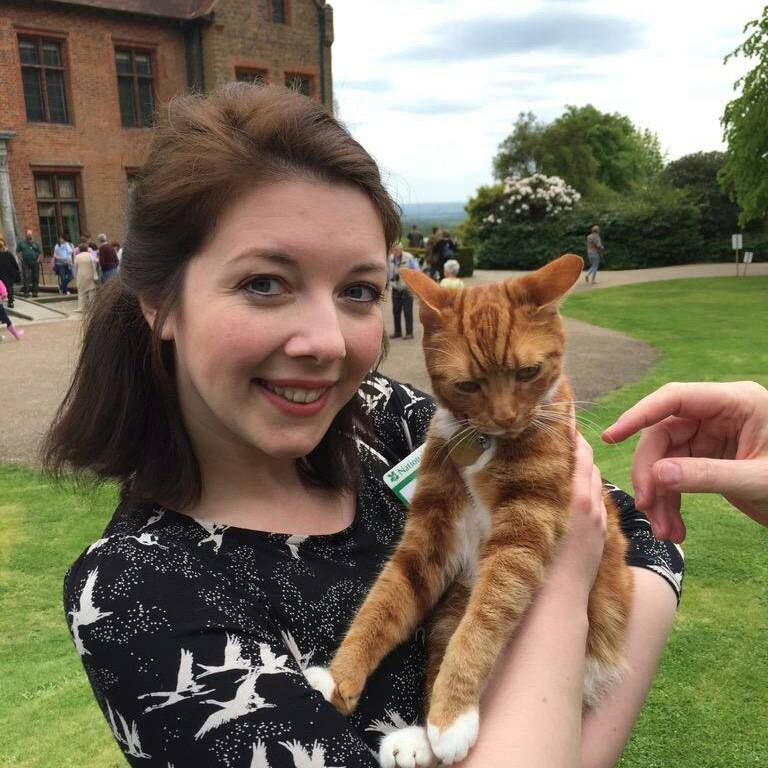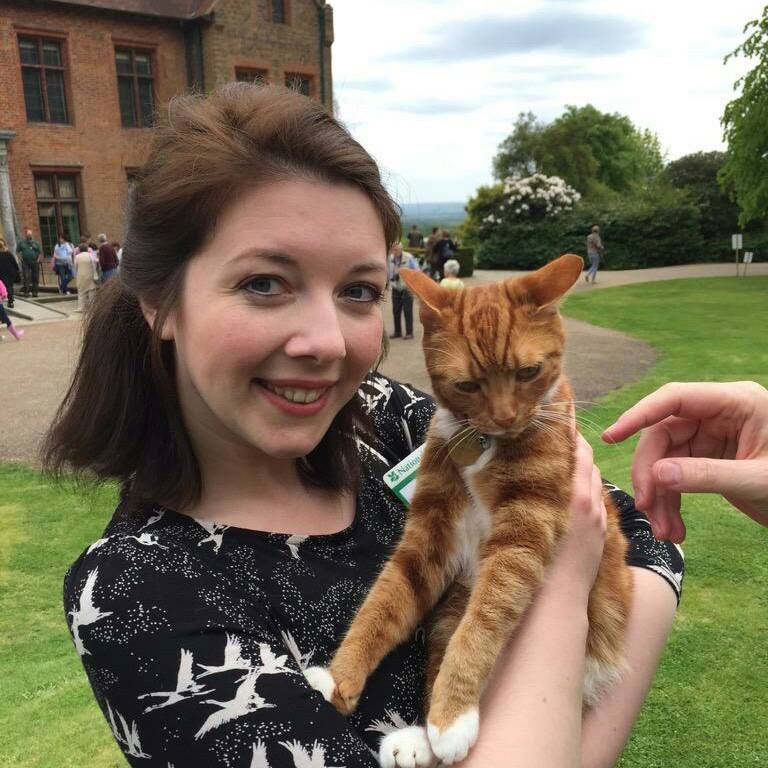
Bulletin #94 - Apr 2016
Meet Chartwell’s House Manager

April 6, 2016
KATHERINE BARNETT is House and Collections Manager for the National Trust at Churchill’s Beloved Country Home

The Chartwell Bulletin recently met with Katherine Barnett (pictured above with Jock VI) to discuss her responsibilities as House and Collections Manager at Chartwell Manor, the National Trust property in Westerham, Kent that was the home of Sir Winston Churchill for forty years.
CB: How did you come to be House and Collections Manager of Chartwell?
KB: I started working at Chartwell in 2014, following a lifelong interest in history and having studied at Durham University. After that I studied for a Masters Degree in Museum and Artefact Studies and went on to work in the commercial world of art and antiques. I longed to get back into heritage as I really missed learning about and sharing my passion for history. After some time working for the National Trust at a different property, the opportunity to join the Chartwell team arose and I couldn’t apply quickly enough. I’ve been fascinated by early twentieth-century history for as long as I can remember so looking after the house and collection at Chartwell is a dream job—I really do have to pinch myself!

2024 International Churchill Conference
CB: What do your duties include?
KB: Lots! I organise loans, curate exhibitions, and manage the care and conservation of the collection and historic interiors. I also manage a team of ten staff and more than 200 volunteers who are all fantastic, and I’m so lucky to get to work with them. It’s a huge role with considerable responsibilities, but I love every minute, whether it’s organising restoration of one of Sir Winston’s wonderful paintings, to writing the narrative for a new exhibition to helping answer research enquiries for a member of the public. No two days are the same and that’s one of the things I love most about my role at Chartwell.
CB: How much space do you have for temporary exhibits, and what goes into deciding what these should be?
KB: For changing exhibitions we have our very-well-titled “Exhibition Room” which has five cases and can be transformed to tell different stories of Sir Winston Churchill. To begin with, I come up with what is hopefully an original idea and then propose it to my colleagues, following which we commence the research and planning. The exhibitions I’ve curated so far have been “Death of a Hero,” which was to mark the fiftieth anniversary of Sir Winston’s passing, and “Into the Trenches,” which marked 100 years since Sir Winston went to fight at the Western Front during the First World War. These exhibitions also give us a great opportunity to bring never-before-seen objects out of store, or allow close-up viewing of objects that may otherwise be tricky to see in our showrooms.
CB: What is a typical day at Chartwell?
KB: We start the day by undertaking our clean of the house and carrying out any conservation and/or maintenance work that may be needed in both the House and the Studio (as we are open seven days a week, this time really is vital to maintain the collections). We then have our wonderful room stewards arrive just before opening, and where possible I make sure I attend the morning brief so I can let the team know if there’s anything they should be aware of (e.g. VIP visitors, objects that may be off display for conservation work, upcoming events that may be of interest, etc.). Once we open we typically welcome around 1000 people a day to the house and studio. Visitors get to experience Sir Winston’s home as he and the family intended. Once open that’s when myself and my team undertake inventory checks, schedule conservation work, work on loans, answer historic enquiries, write articles, complete health and safety checks, carefully manage our light and humidity levels, write project proposals, answer volunteer queries, write interpretation and any other task that comes our way, for instance, answering some lovely questions for the Chartwell Bulletin as I am today.
CB: What are some of the intriguing things about Churchill that you have learned as Manager?
KB: The thing I’ve feel I’ve been most surprised by is the softer side of Sir Winston Churchill. His iconic achievements as a writer, orator, and wartime leader are obviously very well-known, and I had long held an interest in these before my time at Chartwell; but his passion for painting, his love of animals, and the relationships between he and his family all demonstrate that there is so much more to the man behind the statesman. Some of the letters between Sir Winston and Lady Churchill for example are so heartfelt and beautifully written that you can tell what a rock she was to him and how devoted they were to each other.
CB: Is it true that you get to live in Winston Churchill’s house?
KB: I do indeed. I live in some rooms in the attic that were mostly servant’s quarters originally—so I definitely know my place! It is an honour beyond words to share a front door with Sir Winston Churchill, but I have to be very careful and respectful of the space that I am fortunate enough to call home.
CB: What are some of the things you do at Chartwell to promote Churchill studies in schools?
KB: We get a huge number of young families visiting Chartwell and the increasing presence of Sir Winston Churchill in the National Curriculum for history is ensuring that he remains in the forefront of teaching in schools. We host a public speaking competition as well as workshops for schoolchildren, which is a key part of our engagement with schools. In addition to this we are in close contact with local schools and teachers to offer any help or guidance as and when we can.
CB: Do you have any stories about people visiting Chartwell that are particularly memorable?
KB: There have been many memorable visitors to Chartwell in the time that I have been here ranging from heads of state to television personalities to lesser known individuals with wonderful stories to tell. Among my favourites are visitors who worked with the Churchill’s at Chartwell, Chequers, Downing Street, or Hyde Park Gate and reminisce about what life was like with the family. It’s these people whose stories we can keep alive here at Chartwell, like remembering when the Dining Room (as currently displayed) was the Cinema Room and the films that the Churchill’s used to watch, or recalling which newspapers on Fleet Street would be called directly at midnight to get the headlines for the next day, or the stories about working into the early hours to keep up with Sir Winston’s dictation on a noiseless typewriter. It’s these memories that can add even more to the information that we share with our visitors and it is these visitors who are therefore the most memorable to me.
CB: What responsibilities are involved in maintaining the stately home of the resident feline Jock VI?
KB: Jock VI is a wonderful character and as his “custodian” it’s my job to look after him but also ensure he’s conducting his visitor-facing duties. We get so many visitors here desperate to see him, so where possible we try to make sure he’s out and about to be seen. Fortunately he’s a very outdoorsy cat, and with eighty acres to roam around, who can blame him! Sometimes he does sneak under Lady Churchill’s bed though, which can provide a spot of hilarity for our visitors when there are several members of my team trying to retrieve him.
CB: What does Katherine Barnett do when she is not immersed in managing Chartwell?
KB: I am such a history fan that I do like to spend my time visiting museums and historic houses whenever I can—the National Portrait Gallery in London is a favourite for me as I love being up close to the pictures of the great and the good (and sometimes not-so-good) from history. I enjoy ballroom dancing, and I was very lucky to meet my fiancé through that, so I am fortunate as I’m never without a partner. I also like to keep fit too, and it’s lovely to be able to run around the grounds here at Chartwell. Apart from that I love to read, travel, or spend time with friends and family.
For information about visiting Chartwell, please CLICK HERE.
Subscribe
WANT MORE?
Get the Churchill Bulletin delivered to your inbox once a month.




